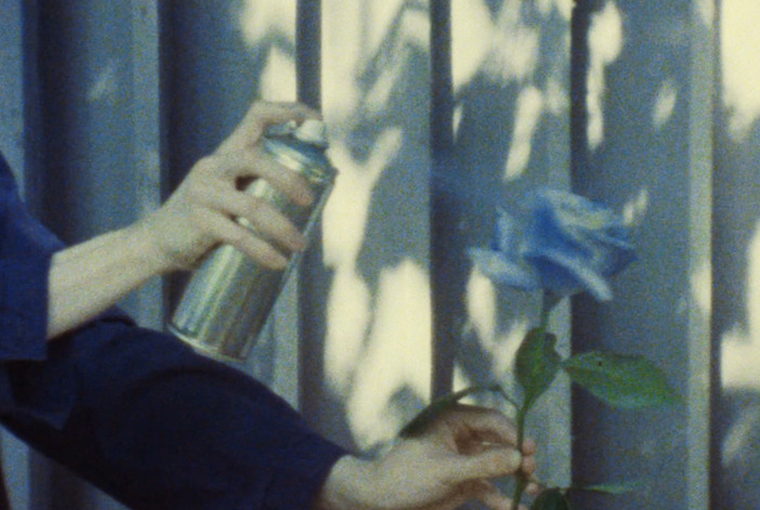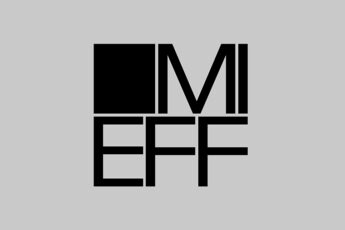Rose-Tinted Glasses: The Politics of Visual Nostalgia
Anya Tsyrlina’s All Other Things Equal (2020) & Olya Korsun’s Blue Rose (Sinyaya roza, 2020)
Vol. 107 (September 2020) by Zoe Aiano
Despite decades of media evolution in the realms of both professional and amateur filmmaking spanning various forms of tape and digital formats, film somehow still reigns supreme as the dominant conveyor of memory, even among the generations that came after its demise. More precisely, it provides a shorthand for evoking nostalgia – when we see an image presented in a certain kind of celluloid, we are instantly aware that this image is of something lost, and that this loss is to be mourned.
In both form and content, Anya Tsyrlina’s short All Other Things Equal is predicated on the signifiers of 35mm used in the service of propaganda. Consisting entirely of re-edited found footage, specifically government-issued portraits intended to exalt the female ideal of the time, it forms an elegy of Soviet womanhood throughout the 1970s and 1980s. In the recognizable greenish hues of the era and the soft grain of the film stock, we witness snapshots of women going about their lives. Many of the fleeting moments captured depict the banalities of daily life, with women walking through parks or streets, reading books or talking with friends. As only befitting the time and place, much of the excerpts are dedicated to the world of work. In both spheres of leisure and labor, in addition to typically “female” activities (teachers, mothers, models, etc.) we are also shown women in endeavors not traditionally considered part of their domain – botanists, geologists, geographers, physicists and soldiers.
The ideology of the images is self-evident through the visual coding of the source material, but by extracting them from their original context through this montage, Tsyrlina incites a new reading. The film doesn’t deny or reject the original intentionality but reclaims and subverts it playfully. While these individuals were selected as being representative of the zeitgeist, with the removal of the contextualization they go back to being individuals. There is no dialogue to detract or distract. There are no men to serve as a reference or comparison, nor to objectify. Some of these women are aware of the camera’s presence and respond accordingly, with performance or embarrassment, while others appear to be captured unknowingly. In any case, the observer-observed relationship is freed of the burden of the male gaze in the traditional sense, even if it is then complicated by the subject-object dynamics inherent to this kind of politicization. The utopian atmosphere created by the absence of men is further emphasized by the sentimental longing of the soundtrack, which, given that no composer is listed in the credits, presumably also came from the propaganda films.
The postulation of the title, “All Other Things Equal”, thus has two inferences. The first refers to questions of gender – how would women be if they were given the same opportunities as men? The answer seemingly presented in the film is that, first of all, they would function perfectly well, and, second, there would be ample space for variety that encompasses conventional femininity without clinging to it exclusively.
The second, more complex, hypothetical comparison relates to socio-economic equality. On the one hand, it is easy to read the film as a rebuke to audiences who may erroneously assume that opportunities for women were more limited under Socialism than they were under Capitalism. Indeed, not only did the Soviet Union have a much more impressive record than the West in terms of the education of women and their employment in a variety of fields, notably STEM, recent research also claims that women had better sex under Socialism.1 In this sense, the “things being equal” can be viewed as referring to the foundational equality of socialist ideology, and it is certainly the case that women on the Eastern side of the Iron Curtain had access to many opportunities that those on the West didn’t in terms of labor rights, childcare etc.
However, it would of course be reductive to make simplistic statements about one side being better than the other. As highlighted by a current traveling exhibition first launched at the Women’s Museum in Moscow,2 at the exact time depicted feminists were forced into exile for criticizing state suppression of women. There is also the notorious issue of the “double burden” that followed on from the early attempts at emancipation, in which women were expected to be a full member of the labor force while also continuing the duties of the matriarchal role domestically.
In the synopsis, the filmmaker states her intention to “create [a world] that does not map easily onto the contemporary notions and stakes of western feminism,” though perhaps it would be more accurate to say Capitalist feminism rather than Western, which covers a lot of divergent ground. First of all, it is worth considering how this Soviet interpretation of the role of women compares to that of present-day Russia. Secondly, inherently anti-capitalist movements such as intersectionality are specifically intended to embrace a variety of perspectives. Indeed, one glaring issue in the film is the whiteness of all the women presented, despite the USSR notoriously comprising a sixth of the world’s surface and all the diversity that scale entails. This is presumably a reflection of the politics of the time, but nevertheless it is something that plays against a positive reading of the ideas presented. As such, the film is perhaps most interesting if viewed not as oppositional, but as part of a broader dialogue.
Another Russian film that explores the sentimental tropes associated with celluloid is Olya Korsun’s Blue Rose. A hybrid between a poem, a love letter and an essay, it explores our shifting relationship to another canonical cliché of femininity: flowers. Divided into thematic chapters, it follows a rough progression of ideas that respond to the question of what our relationship to flowers can teach us about our relationship to the world.
The first section of the film plays heavily into the visual cues of nostalgic reminiscence, with saturated colors and no shortage of light leaks. Combining the director’s own personal family photos with both old super 8 footage and a sequence of young girls frolicking (which was presumably shot in the present day but altered to match the vintage materials), it specifically addresses notions of the innocence of lost childhood and the idea of an ingenuous, as well as a supposed instinctive symbiosis between nature and children. The past being looked back on with such longing is Korsun’s own childhood, but as this also coincides with the Soviet era, it is only natural to apply these same sentiments of loss to the socio-economic context. However, while Korsun’s voiceover postulates the existence of an impulse towards nature intrinsic to Soviet citizens, she also specifies that the outlet it was given by the state was restricted to very limited boundaries and constituted a poor pay-off for being confined to cramped city apartments for the majority of the time.
Thankfully, each chapter adopts a visual language of its own, and as such this deluge of kitsch is largely limited to the first two. However, that said, the whole film maintains a certain visual coherence that refers back to this imagery, maintaining a 4:3 aspect ratio throughout along with a graininess and pastel hue added to the presumably digital scenes that cling to the notion of film.
As the film progresses, the focus shifts to the consumption of flowers considered from various perspectives, starting with the commoditization of flowers as imagery, which the film claims has morphed from divine to banal, from revered with a sense of wonder to accepted as an everyday inevitability. As the discourse becomes more concrete, so too does the visual approach. It takes a (welcomingly) jarring turn by fully entering the present day and abandoning all bucolic idealism to face the surreal reality of a massive flower market in Holland. Shot from above with frames that emphasize the scale and unnatural geometry of the space, seemingly infinite shelves of plants are conveyed throughout unending grey halls. Meanwhile, workers behind equally endless rows of computers grapple with the algorithms and process required to send them across the globe. These are the ugly mechanics that now underpin the superficial appearance of natural beauty.
Back in Russia, this dystopian nightmare is somewhat mitigated in a scene that gives voice to the people on screen for the first time. In a flower market in Moscow, a wide variety of market sellers discuss their personal relationships to the commodity through which they earn a living, bringing the human element back into the global economic equation. This is then followed by yet another drastic stylistic turn, using animation to tell the story of the titular blue rose, a flower that doesn’t exist in nature and has become something of a holy grail of genetic engineering.
Despite the obvious associations of the floral and the feminine, gender remains a sub-text, alluded to only on occasion, such as the comparison made between a flower that dies to be placed in a vase and a young bride losing her identity through marriage, or the vendor who insists men buy flowers and women only receive them. Though the first-person narration and the different sections meander in various directions, the strands always come back to the underlying question of the implications of flowers on a societal level. The closing chapter underlines this by ruminating on the relevance of the philosophy of ikebana in relation to raising children, with the aim of allowing each individual to flourish on their own terms but in harmony with and to the mutual benefit of the whole. While the film is arguably overburdened with its many ideas and styles, there is ultimately enough depth in both to justify the approach.
Often in experimental cinema, the use of film can end up as fetishization or lazy mimicry of the prevailing idea of how an experimental film should look, but in these cases both filmmakers manage to justify their decision overall. In adopting a nostalgic lens to look back at a past that is both over-vilified and over-idealized, they challenge viewers to look beyond the surface to reflect more meaningfully on how that past can be brought into the dialogue of the present.
References
- 1.Ghodsee, K. .R. . (2017). The New York Times. Retrieved 15 August, 2020, from https://www.nytimes.com/2017/08/12/opinion/why-women-had-better-sex-under-socialism.html.
- 2.Friedlander , E. (2020). The Calvert Journal. Retrieved 15 August, 2020, from https://www.calvertjournal.com/articles/show/11906/woman-and-russia-feminist-zine-samizdat.




Leave a Comment